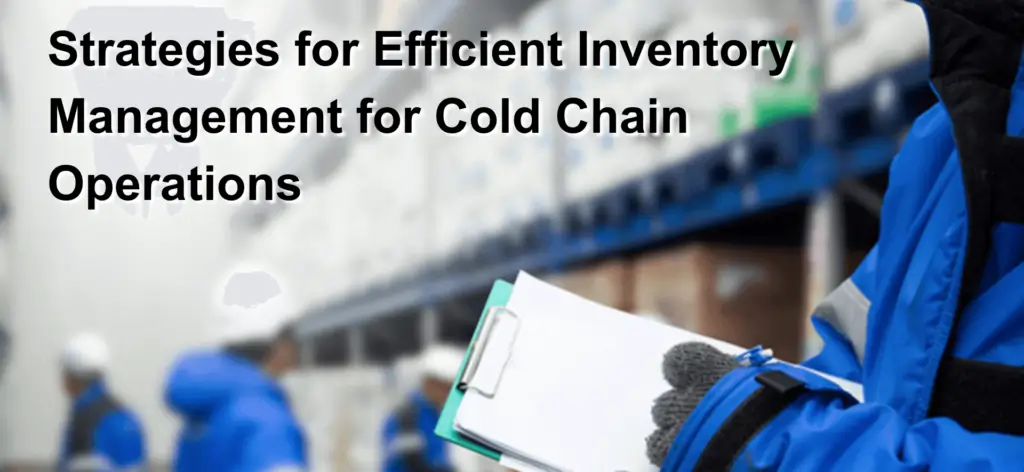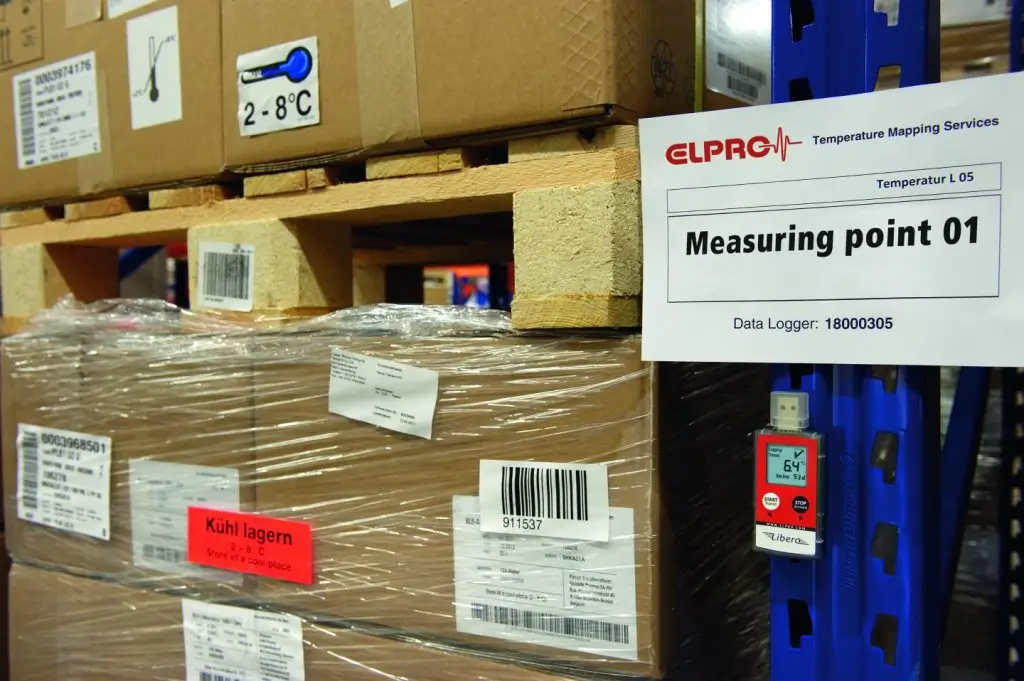
Article’s Summary
- Real-time monitoring and tracking systems ensure product quality and prevent spoilage in cold chain operations.
- Efficient warehouse layout and organization minimize temperature fluctuations and cross-contamination.
- Collaboration with suppliers and customers improves inventory management and responsiveness to market demands.
- Implementing inventory optimization techniques like JIT and EOQ reduces costs and prevents overstocking or stockouts.
- Proper training on temperature control equips staff to make informed decisions and maintain product integrity.
Welcome to the fascinating world of cold chain operations, where the transportation, storage, and handling of temperature-sensitive products become the main focus. In this realm, efficient inventory management plays a pivotal role in achieving success. Why is it so important, you ask? Well, it all comes down to preserving the top-notch quality of products, minimizing waste, and optimizing the entire supply chain to ensure the utmost integrity of perishable goods, pharmaceuticals, and vaccines.
In this article, we embark on an exciting journey together, exploring a range of strategies specifically crafted to facilitate efficient inventory management for cold chain operations. These strategies are here to save the day, not only by safeguarding the quality of products, but also by reducing waste and enhancing the overall efficiency of the supply chain. By embracing these approaches, businesses can go above and beyond to deliver exceptional customer satisfaction and pave the path towards resounding success. So, let’s dive right in and uncover the secrets to effective inventory management in the captivating world of cold chain operations!
Implement Real-time Monitoring and Tracking

Keeping products in optimal condition is extremely important in cold chain operations. When it comes to temperature-sensitive items like perishable food, pharmaceuticals, and vaccines, it’s crucial to maintain specific temperature ranges to ensure their quality and effectiveness. Thankfully, there are advanced monitoring systems available that make use of IoT-enabled sensors, data loggers, and RFID technology. These systems provide constant visibility into inventory conditions, allowing businesses to track temperature, humidity, and location throughout the supply chain. With real-time data at their disposal, businesses can quickly spot any deviations from ideal storage conditions and take immediate action to prevent spoilage, product deterioration, and potential health risks for consumers.
With real-time monitoring and tracking systems, businesses can enjoy a greater level of transparency and visibility throughout the entire cold chain supply chain. By integrating advanced technologies like GPS and RFID, they gain the ability to track the location and movement of their inventory at any moment. This heightened visibility empowers businesses to closely monitor the progress of shipments, make informed decisions about routing, and ultimately enhance the efficiency of their entire supply chain. It’s like having a helpful guide that ensures everything is on the right track and running smoothly.
The cold chain industry is subject to stringent regulatory standards to ensure the safety and quality of temperature-sensitive products. Real-time monitoring and tracking systems play a crucial role in helping businesses comply with these regulations. By maintaining a comprehensive record of temperature and other environmental conditions throughout the supply chain, businesses can demonstrate compliance during audits and inspections. The ability to provide detailed reports and traceability ensures accountability and helps build trust with regulatory authorities, customers, and partners.
Accurate Demand Forecasting

Accurate demand forecasting forms the foundation of efficient inventory management. Understanding customer demand patterns, seasonal variations, and market trends allows cold chain operators to plan their inventory levels effectively. Utilizing historical sales data, market research, and collaboration with suppliers and customers can provide valuable insights for demand forecasting. Advanced analytics and machine learning algorithms can help analyze large datasets and make accurate predictions, reducing the risk of overstocking or understocking inventory.
Layout and Organize your warehouse efficiently

Cold chain warehouses often house products with varying temperature requirements, ranging from frozen to refrigerated to ambient. Designing the warehouse with clearly defined zones for each temperature category ensures that products are stored under appropriate conditions. This zoning approach facilitates efficient inventory management by minimizing the risk of temperature fluctuations and cross-contamination. By segregating products based on their specific temperature needs, businesses can maintain product integrity, comply with regulatory requirements, and mitigate the potential for quality issues.
By using a warehouse management system (WMS), businesses can make the most out of their storage capacity and create efficient space utilization. Instead of relying on guesswork, they can analyze product dimensions, demand patterns, and turnover rates to figure out the best storage methods. This could include using high-density racking systems or automated storage and retrieval systems (AS/RS). Taking a people-centric approach, businesses strategically place their inventory, which reduces unnecessary travel time and boosts operational efficiency. Say goodbye to wasted space and hello to a well-organized warehouse that works smarter, not harder!
Assign unique identifiers, such as barcodes or RFID tags, to each product, businesses can streamline inventory management and reduce the chances of errors during order fulfillment. Additionally, employing clear signage and standardized labeling practices throughout the warehouse enhances accuracy and facilitates efficient product retrieval.
Collaborate with Suppliers and Customers

Collaboration is key to achieving efficient inventory management in cold chain operations. Establishing strong partnerships with suppliers and customers fosters better communication, visibility, and coordination throughout the supply chain. Sharing information regarding demand forecasts, production schedules, and inventory levels enables a more synchronized approach to inventory management. By aligning production and delivery schedules with customer demand, businesses can reduce lead times, improve order accuracy, and optimize stock levels. Collaborative forecasting and planning with suppliers and customers can result in lower inventory carrying costs, improved responsiveness to market demands, and enhanced customer satisfaction.
Implement Inventory Optimization Techniques

To achieve this delicate balance, businesses in the cold chain industry must embrace inventory optimization techniques that enable them to strike the right equilibrium between product availability and cost efficiency. Below are the inventory optimization techniques in cold chain operations that we need to maximize.
- Just-in-Time (JIT) Inventory Management
Just-in-time (JIT) inventory management is a strategy that involves receiving inventory as close to the time of use as possible. By minimizing excess inventory and storage costs, JIT aims to reduce waste and improve operational efficiency. In the context of cold chain operations, where perishable products are involved, JIT can play a crucial role in maintaining product freshness and quality. By leveraging accurate demand forecasting, collaborative planning with suppliers, and streamlined logistics, businesses can ensure that inventory arrives precisely when needed, minimizing the risk of excess inventory or stockouts. The human-centric approach of JIT empowers businesses to optimize their inventory levels while meeting customer demand and maximizing cost-effectiveness.
- Economic Order Quantity (EOQ) Calculations
Economic order quantity (EOQ) calculations are a fundamental technique in inventory optimization. EOQ helps determine the optimal order quantity that minimizes total inventory costs, taking into account factors such as ordering costs and carrying costs. By finding the sweet spot where the cost of holding inventory balances with the cost of replenishment, businesses can make informed decisions about order quantities and frequencies. In cold chain operations, where inventory carrying costs can be significant due to temperature-controlled storage requirements, EOQ calculations can be particularly valuable. By considering variables such as product shelf life, storage costs, and transportation costs, businesses can strike the right balance and optimize their inventory levels while keeping costs in check.
- Safety Stock Analysis
Safety stock analysis is a critical aspect of inventory optimization in cold chain operations. It involves identifying the buffer stock needed to address unforeseen demand fluctuations or supply disruptions. In the context of temperature-sensitive products, where unexpected events like equipment failures or transportation delays can jeopardize product integrity, maintaining an appropriate safety stock is vital. By analyzing historical demand patterns, lead times, and variability, businesses can determine the level of safety stock necessary to mitigate risks and ensure continuity in their operations. This human-driven approach allows businesses to maintain a cushion against uncertainties while safeguarding customer satisfaction and product quality.
Implementing inventory optimization techniques is a cornerstone of efficient inventory management in cold chain operations. By embracing just-in-time (JIT) inventory management, conducting economic order quantity (EOQ) calculations and performing safety stock analysis, businesses can achieve the delicate balance between product availability and cost efficiency.
- Train your staff on cold chain logistics
One of the foundational pillars of cold chain logistics is temperature control. It is essential for your staff to grasp the critical role it plays in preserving product quality, ensuring food safety, and meeting regulatory requirements. Training should focus on educating your team about the impact of temperature fluctuations on perishable goods, emphasizing the potential consequences of failing to maintain proper storage and transportation conditions. By fostering a deep understanding of the importance of temperature control, your staff will be equipped to make informed decisions and take appropriate actions to uphold product integrity at every stage of the cold chain.
What are the importance of implementing Strategies for Efficient Inventory Management for Cold Chain Operation

Efficient inventory management lies at the heart of successful cold chain operations. Whether it’s transporting perishable goods, vaccines, or pharmaceuticals, maintaining the integrity and quality of products throughout the supply chain is paramount. By implementing strategies for efficient inventory management, businesses can optimize resources, reduce waste, ensure product freshness, and meet customer demands.
Meeting Customer Expectations
In today’s competitive market, customer satisfaction is vital for business success. Effective inventory management allows you to fulfill customer orders promptly, preventing stockouts and delays. By accurately forecasting demand and maintaining adequate inventory levels, you can provide a seamless customer experience, enhancing trust and loyalty.
Minimizing Costs and Waste
Efficient inventory management helps businesses minimize costs and reduce waste. By adopting strategies such as the FIFO principle and real-time tracking, you can prevent product expiration, spoilage, or obsolescence. This not only saves money but also reduces environmental impact by minimizing waste generation. Optimizing inventory levels also frees up valuable storage space, allowing businesses to maximize their resources effectively.
Ensuring Product Integrity
For cold chain operations, maintaining product integrity is crucial. Proper inventory management, including temperature monitoring and control, ensures that goods are stored and transported within the required temperature range. This minimizes the risk of spoilage, bacterial growth, and degradation of quality. By implementing rigorous inventory management practices, you can safeguard the efficacy and safety of sensitive products, such as vaccines or biologics.
Streamlining Supply Chain Operations
Efficient inventory management optimizes the flow of goods throughout the supply chain. Collaboration and effective communication with suppliers, distributors, and transporters enable timely and accurate replenishment, reducing lead times and enhancing overall operational efficiency. Streamlined supply chain operations result in faster order processing, reduced stock holding costs, and improved responsiveness to market fluctuations.
Reducing Risks and Ensuring Compliance
In the cold chain industry, regulatory compliance is of utmost importance. Proper inventory management ensures adherence to regulatory guidelines and quality standards. Accurate record-keeping, thorough audits, and robust inventory control systems minimize the risk of non-compliance, which could lead to costly penalties, reputation damage, and legal ramifications. By implementing efficient inventory management strategies, you create a foundation for compliance and risk mitigation.
Continuous Improvement and Adaptability
The business landscape is dynamic, and cold chain operations are no exception. Implementing strategies for efficient inventory management encourages continuous improvement and adaptability. By analyzing data, seeking feedback, and embracing technological advancements, businesses can identify areas for optimization and implement innovative solutions. By staying proactive and adaptable, you can ensure your inventory management practices remain effective in a rapidly evolving industry.
Efficient inventory management is the lifeblood of a successful cold chain operation. The human touch applied to the strategies employed plays a vital role in ensuring smooth operations, meeting customer needs, reducing costs, and maintaining product quality and safety.
By understanding customer demands and accurately forecasting inventory requirements, businesses can optimize stock levels and prevent stockouts or excess inventory. This human-centered approach enables them to respond promptly to customer orders, build trust, and foster long-term relationships.
Efficient inventory management also minimizes costs and waste. By implementing practices like the FIFO principle and real-time tracking, businesses can prevent product spoilage, reduce the risk of obsolescence, and minimize unnecessary expenditures. This not only benefits the bottom line but also demonstrates a commitment to responsible resource management and sustainability.
The human element in inventory management is crucial for maintaining product integrity throughout the cold chain. Rigorous temperature monitoring and control ensure that perishable goods, vaccines, or pharmaceuticals are stored and transported under the required conditions. This human vigilance safeguards the effectiveness and safety of products, assuring customers and regulatory bodies alike.
Collaboration and effective communication among stakeholders are essential for successful inventory management in the cold chain. By working closely with suppliers, distributors, and transporters, businesses can optimize supply chain operations, minimize delays, and improve overall efficiency. These human connections build a network of trust and reliability, crucial for the smooth flow of goods.
The human touch is also vital for ensuring compliance with regulatory requirements. Accurate record-keeping, meticulous audits, and stringent quality control measures help businesses navigate complex regulations. By prioritizing compliance, businesses mitigate risks, safeguard their reputation, and build credibility in the industry.
Finally, the willingness to adapt and continuously improve inventory management practices is key. By embracing feedback, analyzing data, and exploring new technologies, businesses can enhance their processes and stay ahead of the competition. This human-driven mindset fosters innovation and drives the growth and success of cold chain operations.
In summary, when it comes to efficient inventory management in cold chain operations, it’s all about putting people at the center. By truly understanding what customers need, minimizing costs and waste, and making sure products stay in top shape, businesses can thrive in the ever-demanding world of cold chain logistics. Collaboration is key, as well as staying compliant with regulations and always striving for improvement. By following these principles, businesses can achieve operational excellence, keep customers satisfied, and secure their long-term success in the cold chain industry.
Click here to find out more about Cold Chain Packing & Logistics today.